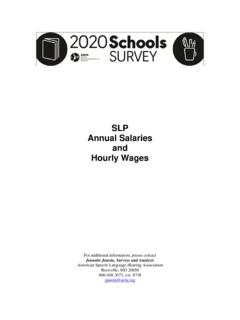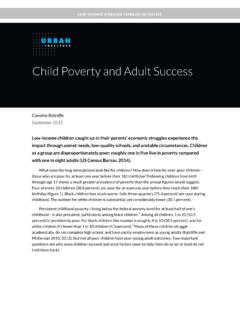Transcription of 8-Gender Discrimination in Educational Personnel A Case of ...
1 US-China Education Review B 7 (2012) 689-696 Earlier title: US-China Education Review, ISSN 1548-6613 Gender Discrimination in Educational Personnel : A Case Study of Gweru urban District Secondary Schools, Zimbabwe Nogget Matope Midlands State University, Gweru, Zimbabwe Gender Discrimination in Educational institutions persists, despite the vigorous pursuit of policies and programmes to reduce the varying degrees of gender inequity in Zimbabwe. Zimbabwe is a signatory to international agreements and conventions which promote gender equity with a thrust towards increased access to education for girls and females. The creation of a healthy Educational and social environment in which all people irrespective of gender are encouraged to fully utilize their skills and talents would be an effective tool to eliminate discriminatory practices and tendencies in the education system. Using a survey design and document analysis, this study investigated the practices perceived to constitute Discrimination among Educational Personnel in secondary schools in Gweru urban District.
2 A total of 120 Educational Personnel drawn from 12 secondary schools responded to questionnaire and a sample out of 20 with face-to-face interviews. Analyzed data revealed that gender Discrimination in learning institutions exists and is manifested in the appointments, promotion and assignment of duties and responsibilities. As a result, women seem to be negatively affected, in the low uptake of administrative positions. The government and the Ministries of Education need to implement professional development programmes on gender issues which raise awareness on the status, role, and contribution of both females and males in education and Educational management. This effort would promote a cultural climate, within which females see themselves as leaders and males see women as capable leaders and decision-makers. This effort would promote gender equality and gender empowerment, and minimize gender prejudices in Educational institutions.
3 It is envisaged that this would help build a critical mass of females in decision-making processes as well as gender equity initiatives which are visible and vibrant with gender disaggregated data available in all Educational institutions. Keywords: gender Discrimination , gender equity, female Educational Personnel Introduction The Nziramasanga Commission on Education (1999) recommended the building of a critical mass of females in decision-making processes through Educational empowerment especially at higher education and the creating of a cultural climate, within which females see themselves as leaders and males see females themselves as leaders and males see females also as potential leaders. Research has shown that gender Discrimination among Educational Personnel is evident and is caused by a wide range of factors which hinder female participation in school leadership. The National Gender Policy (2004) defined gender Discrimination as unequal or preferential treatment of individual or groups based on their gender that results in reducing access to or control of resources and opportunities.
4 The issue of gender Discrimination is a human resource challenge. Nogget Matope, lecturer, Gender Studies Department, Faculty of Education, Midlands State University. D DAVID PUBLISHING GENDER Discrimination IN Educational Personnel 690 Gender stereotypes, sexist language, sexual harassment among others contribute to making the unfavourable for the female employees especially. Gender Discrimination among Educational Personnel is evident in the recruitment, appointment, deployment, and promotion in school . It is evident that few females are in administrative posts, despite government s efforts to implement the pronouncements of the SADC (Southern Africa Development Community) Protocol on the third of posts to be held by females. The subject of gender equity is one which has received a great deal of attention internationally especially after the UN (United Nations) identified it as a key factor in development of nations.
5 In developing countries, governments and communities are vigorously pursuing policies and programes to reduce various degrees of gender inequity. In line with this, Zimbabwe is a party of the following: the UN CEDAW (United Nations Convention on the Elimination of All Discrimination Against Women) (1979), the World on Education for All (1990) which emphasized most urgent priority to ensure access to and improve quality of education for girls, the 5th African Regional Conference on Women (1995) and declaration of OAU (Organisation of African Unity) (now AU (African Union)) of 1997, 2006 as African Decade for Education, The Kampala Declaration Framework for Action (1996). These policies and protocols demonstrated the government s thrust to bridge the gender gap. Gender equity empowers females and males to equally play their parts in development. In 1999, the Nziramasanga Commission on Education had recommended that a Gender Equity Council or Commission was set up to monitor and advised on the implementation of gender equity practices in both private and public sector activities and programs.
6 To date, this has not been fully realized and gender Discrimination has been persisting. However, the National Gender Policy (2004) recognized that gender equality was a key to the Millenium Development Goals and proposed to strengthen Educational Personnel at all levels to address gender issues. One of the strategies that have been implemented is affirmative action, through which, more females are promoted into important and influential positions of leadership. Studies done in developed countries, such as the UK and the Netherlands (Dawtrey, 1995), and USA (Gunier, Fine, & Balin, 1994) concluded that females were marginalized, as most schools were predominated by male teachers, and this made the female teachers to feel intimidated and alienated from their work and environment. Most studies seemed to suggest that both female and male employees do not have much confidence in female leaders.
7 This emanated from a number of perceptions and stereotypes which continued to confine females in the private sphere. This paper explores the gender Discrimination among Educational Personnel as well as the practices that hinder the empowerment of women and their impact on Personnel in school . The study maintains that most females face discriminatory practices which hinder their full participation in leadership positions. Through the analysis of socio-cultural and economic factors, it is suggested that cultural beliefs and practices support, and sustain gender inequality. There are a lot of researches that provided evidence on the high incidence of gender Discrimination amongst females. Females are mostly discriminated, because of race, class, disability and as a result of the clashes that were prioritized in the dominant society. Other studies stressed the impact of gender related expectations, attitudes and stereotypes as main factors in gender Discrimination as well as patriarchal value systems which supported gender inequalities.
8 Connell (1995) defined hegemonic masculinity as the configuration of gender practices which embodied the current legitimacy of patriarchy that involved the dominant position of men and the subordination of women. GENDER Discrimination IN Educational Personnel 691He maintained that hegemonic masculinities are not fixed types, but a configuration of practices which stemmed from concrete situations where may change. Studies which have been done also showed that prejudices, sexual innuendos at work, discriminatory practices may motivate decisions in hiring, promotion, and appraisal of Personnel within the work environment and education is not an exception. According to McFadden (1998), putting relations of power and gender inequality at the forefront of African scholarship would cater for some of the inadequacies of mainstream theoretical frameworks. As one of the major influences in the area of consciousness, Freire (2000), Pedagogy of the Oppressed, proposed a learning process that provided a context for people to critically examine their realities and actively participate in creating their own knowledge.
9 The ultimate goal was to transform the individual and collective consciousness which resulted in action against oppressive structures in society. Within this critical consciousness, Freire viewed both the researcher and those who had been researched as equal partners in the research process and production of knowledge (Brydon-Miller, 2001). Therefore, as equal partners in the research process, the researcher continuously involved the participants in the research process. Methodology The study was qualitative in nature and it sought to establish the discriminatory practices that hinder female empowerment and participation in schools. The study sought to gather the true and actual feelings, opinions, attitudes, and perceptions of the respondents. Qualitative study was used, because it is interactive (Silverman, 2005). The study employed a qualitative case study research strategy.
10 This case study was chosen, as it enables the author to study phenomena in greater depth so as to reach a deeper understanding (Cresswell, 2005). The author purposively sampled 120 Educational Personnel drawn from the 12 secondary schools in Gweru urban District. Purposive sampling makes use of the research, participants who possess desirable research characteristics (Seale, 2006). The study employed the interview method which comprised open ended questions that sought for descriptive and narrative responses regarding the phenomena under study (Thomas & Nelson, 2001). Semi-structured in-depth interviews, ranging from one hour to two hours were conducted to access participants subjective experiences and meanings often lost in quantitative research (Banister, Burman, Parker, Taylor, & Tindall, 1994). All interviews were audio-taped, transcribed, and checked for accuracy. After transcription, the interviewees were invited to add questions to interview protocol before and during data collection.












